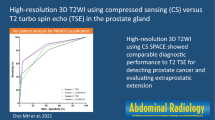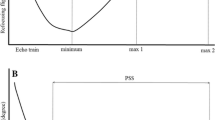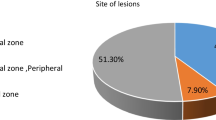Abstract
Purpose
To evaluate revised PROPELLER (RevPROP) for T2-weighted imaging (T2WI) of the prostate as a substitute for turbo spin echo (TSE).
Materials and methods
Three-Tesla MR images of 50 patients with 55 cancer-suspicious lesions were prospectively evaluated. Findings were correlated with histopathology after MRI-guided biopsy. T2 RevPROP, T2 TSE, diffusion-weighted imaging, dynamic contrast enhancement, and MR-spectroscopy were acquired. RevPROP was compared to TSE concerning PI-RADS scores, lesion size, lesion signal-intensity, lesion contrast, artefacts, and image quality.
Results
There were 41 carcinomas in 55 cancer-suspicious lesions. RevPROP detected 41 of 41 carcinomas (100%) and 54 of 55 lesions (98.2%). TSE detected 39 of 41 carcinomas (95.1%) and 51 of 55 lesions (92.7%). RevPROP showed fewer artefacts and higher image quality (each p < 0.001). No differences were observed between single and overall PI-RADS scores based on RevPROP or TSE (p = 0.106 and p = 0.107). Lesion size was not different (p = 0.105). T2-signal intensity of lesions was higher and T2-contrast of lesions was lower on RevPROP (each p < 0.001).
Conclusion
For prostate cancer detection RevPROP is superior to TSE with respect to motion robustness, image quality and detection rates of lesions. Therefore, RevPROP might be used as a substitute for T2WI.
Key points
• Revised PROPELLER can be used as a substitute for T2-weighted prostate imaging.
• Revised PROPELLER detected more carcinomas and more suspicious lesions than TSE.
• Revised PROPELLER showed fewer artefacts and better image quality compared to TSE.
• There were no significant differences in PI-RADS scores between revised PROPELLER and TSE.
• The lower T2-contrast of revised PROPELLER did not impair its diagnostic quality.


Similar content being viewed by others
Abbreviations
- DCE:
-
dynamic contrast enhancement
- DWI:
-
diffusion-weighted imaging
- MRGB:
-
MRI-guided biopsy
- MRS:
-
MR-spectroscopy
- mpMRI:
-
multiparametric MRI
- MVXD:
-
MultiVane XD (Philips Healthcare, Best, The Netherlands)
- PI-RADS:
-
Prostate Imaging-Reporting and Data System
- PROPELLER:
-
Periodically Rotated Overlapping ParallEL Lines with Enhanced Reconstruction
- SENSE:
-
Sensitivity Encoding (Philips Healthcare, Best, The Netherlands)
- TSE:
-
turbo spin echo
- THRIVE:
-
T1 High-Resolution Isotropic Volume Excitation (Philips Healthcare, Best, The Netherlands)
References
Pipe JG (1999) Motion correction with PROPELLER MRI: application to head motion and free-breathing cardiac imaging. Magn Reson Med 42(5):963–9
Wintersperger BJ, Runge VM, Biswas J et al (2006) Brain magnetic resonance imaging at 3 Tesla using BLADE compared with standard rectilinear data sampling. Invest Radiol 41:586–592
Forbes KP, Pipe JG, Karis JP, Farthing V, Heiserman JE (2003) Brain imaging in the unsedated pediatric patient: comparison of periodically rotated overlapping parallel lines with enhanced reconstruction and singleshot fast spin-echo sequences. AJNR Am J Neuroradiol 24:794–798
Nyberg E, Sandhu GS, Jesberger J, Blackham KA, Hsu DP, Griswold MA, Sunshine JL (2012) Comparison of brain MR images at 1.5T using BLADE and rectilinear techniques for patients who move during data acquisition. AJNR Am J Neuroradiol 33(1):77–82
Ohgiya Y, Suyama J, Seino N, Takaya S, Kawahara M, Saiki M, Sai S, Hirose M, Gokan T (2010) MRI of the neck at 3 Tesla using the periodically rotated overlapping parallel lines with enhanced reconstruction (PROPELLER) (BLADE) sequence compared with T2-weighted fast spin-echo sequence. J Magn Reson Imaging 32(5):1061–7
Meier-Schroers M, Kukuk G, Homsi R, Skowasch D, Schild HH, Thomas D (2016) MRI of the lung using the PROPELLER technique: Artifact reduction, better image quality and improved nodule detection. Eur J Radiol 85(4):707–13
Hirokawa Y, Isoda H, Maetani YS, Arizono S, Shimada K, Togashi K (2008) Evaluation of motion correction effect and image quality with the periodically rotated overlapping parallel lines with enhanced reconstruction (PROPELLER) (BLADE) and parallel imaging acquisition technique in the upper abdomen. J Magn Reson Imaging 28(4):957–62
Froehlich JM, Metens T, Chilla B, Hauser N, Klarhoefer M, Kubik-Huch RA (2012) Should less motion sensitive T2-weighted BLADE TSE replace Cartesian TSE for female pelvic MRI? Insights Imaging 3(6):611–8
Rosenkrantz AB, Bennett GL, Doshi A, Deng FM, Babb JS, Taneja SS (2015) T2-weighted imaging of the prostate: Impact of the BLADE technique on image quality and tumor assessment. Abdom Imaging 40(3):552–9
Pipe JG, Gibbs WN, Li Z, Karis JP, Schar M, Zwart NR (2014) Revised motion estimation algorithm for PROPELLER MRI. Magn Reson Med 72(2):430–7
Barentsz JO, Richenberg J, Clements R, Choyke P, Verma S, Villeirs G, Rouviere O, Logager V, Fütterer JJ, European Society of Urogenital Radiology (2012) ESUR prostate MR guidelines 2012. Eur Radiol 22(4):746–57
Hoeks CM, Barentsz JO, Hambrock T, Yakar D, Somford DM, Heijmink SW, Scheenen TW, Vos PC, Huisman H, van Oort IM, Witjes JA, Heerschap A, Fütterer JJ (2011) Prostate cancer: multiparametric MR imaging for detection, localization, and staging. Radiology 261(1):46–66
Weinreb JC, Barentsz JO, Choyke PL, Cornud F, Haider MA, Macura KJ, Margolis D, Schnall MD, Shtern F, Tempany CM, Thoeny HC, Verma S (2016) PI-RADS Prostate Imaging-Reporting and Data System: 2015, Version 2. Eur Urol 69(1):16–40
Barentsz JO, Weinreb JC, Verma S, Thoeny HC, Tempany CM, Shtern F, Padhani AR, Margolis D, Macura KJ, Haider MA, Cornud F, Choyke PL (2016) Synopsis of the PI-RADS v2 guidelines for multiparametric prostate magnetic resonance imaging and recommendations for use. Eur Urol 69(1):41–9
Schimmöller L, Quentin M, Arsov C, Hiester A, Buchbender C, Rabenalt R, Albers P, Antoch G, Blondin D (2014) MR-sequences for prostate cancer diagnostics: validation based on the PI-RADS scoring system and targeted MR-guided in-bore biopsy. Eur Radiol 24(10):2582–9
Zand KR, Reinhold C, Haider MA, Nakai A, Rohoman L, Maheshwari S (2007) Artifacts and pitfalls in MR imaging of the pelvis. J Magn Reson Imaging 26(3):480–97
Wagner M, Rief M, Busch J, Scheurig C, Taupitz M, Hamm B, Franiel T (2010) Effect of butylscopolamine on image quality in MRI of the prostate. Clin Radiol 65(6):460–4
Pandit P, Qi Y, King KF, Johnson GA (2011) Reduction of artifacts in T2-weighted PROPELLER in high-field preclinical imaging. Magn Reson Med 65(2):538–43
Roethke MC, Kuru TH, Radbruch A, Hadaschik B, Schlemmer HP (2013) Prostate magnetic resonance imaging at 3 Tesla: Is administration of hyoscine-N-butyl-bromide mandatory? World J Radiol 5(7):259–263
Author information
Authors and Affiliations
Corresponding author
Ethics declarations
Guarantor
The scientific guarantor of this publication is Guido Matthias Kukuk.
Conflict of interest
One co-author of this manuscript, Jürgen Gieseke, is an employee of Philips Healthcare Germany. However, he did not have any influence on the study design, evaluation, and interpretation of results. He mainly worked on optimising the MR sequences.
Funding
The authors state that this work has not received any funding.
Statistics and biometry
No complex statistical methods were necessary for this article.
Informed consent
Written informed consent was obtained from all patients in this study.
Ethical approval
Institutional Review Board approval was obtained.
Methodology
• prospective
• diagnostic study
• performed at one institution
Rights and permissions
About this article
Cite this article
Meier-Schroers, M., Marx, C., Schmeel, F.C. et al. Revised PROPELLER for T2-weighted imaging of the prostate at 3 Tesla: impact on lesion detection and PI-RADS classification. Eur Radiol 28, 24–30 (2018). https://doi.org/10.1007/s00330-017-4949-y
Received:
Revised:
Accepted:
Published:
Issue Date:
DOI: https://doi.org/10.1007/s00330-017-4949-y




